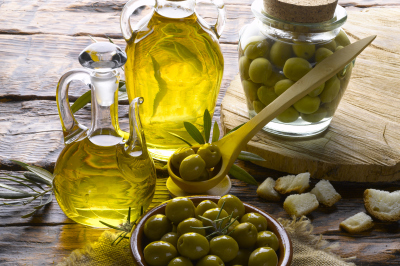
Do you cook with oils?
There are a huge number of plant oils out there on the market, but what benefit do they provide? And how should we be using them?
Here we take a quick look through the oils on offer and provide some tips on how to cook with the.
Rapeseed, flaxseed, cold pressed or extra virgin? Gone are the days when the only “exotic” cooking oil you could lay your hands on was sun-soaked Greek or Italian olive oil. Now there is any number of culinary oils to choose from, and it’s worth drizzling and sizzling a few to experience the different tastes and health benefits they can offer.
It’s time to chew the fat or at least include some nutritious plant oils in your diet to boost your health, says Rachell Hipkiss, Director of Science & Nutrition at Healthspan.
Most plant oils tend to be relatively high in monounsaturates or polyunsaturates, which makes them a better choice than animal fats, like butter and lard, which are rich in saturates. Replacing saturated fat with unsaturated fat helps to reduce heart disease risk and keep cholesterol levels balanced.

OMEGA BONUS
Many plant oils are a rich source of omega 6 essential fatty acids (EFAs), while a few also contain good amounts of the omega 3 group. Both omega 6 and omega 3 EFAs play a crucial role in maintaining brain function, in the health of the skin, hair and bones, and in regulating metabolism and the reproductive system.
Our western diets, however, tend to contain too much omega 6 and not enough omega 3, so it’s worth looking out for oils such as flaxseed and rapeseed that help to redress this balance (and to make sure your diet contains plenty of oily fish or omega 3 supplements too). Too much omega 6 but not enough omega 3 may contribute to inflammation and conditions as diverse as joint pain and cancer.
Although the UK government advises that we should eat three portions of oily fish a week, the latest research indicates that optimum benefits will be achieved from at least double this amount. As many of us have less than even the 3 portions a week, there is sound justification for supplementation of 1 to 2g per day such as Healthspan's Super Strength Omega Oil or a high strength Flaxseed Oil.
CHOOSING AND USING
- Most opened oils keep well in a cool, dark cupboard. Some, like hemp and flaxseed, however, need refrigerating to prevent rancidity, so check labels.
- Cold pressed and extra virgin oils tend to have more beneficial components, but it’s fine to use refined oils for high temperature cooking as they tend to stand up better to heat.
- Re-using oil isn’t a good idea. Fatty acids can degrade into toxic compounds – linked with some cancers – with prolonged heating, so only use once.
Pick & Mix
Extra virgin olive
Famous for its heart-healthy monounsaturate content, it’s also full of antioxidants and phytochemicals.
BEST USE: For drizzling. Cooking can break down the natural waxes, altering the flavour.
Rapeseed
Almost as rich as olive oil in cholesterol-lowering monounsaturates, rapeseed oil also contains some omega 3. Cold-pressed types are generally higher in antioxidants and have more flavour.
BEST USE: A good all-rounder for dressings, stir-fries and baking.
Hemp
Second only to flaxseed oil for omega 3 content, it also contains gamma-linolenic acid – one of the few anti-inflammatory omega 6 fatty acids.
BEST USE: In salad dressings, as it’s heat-sensitive.
Sesame
Containing roughly equal levels of omega 6 polyunsaturates and monounsaturates, sesame is often used in Chinese dishes. Some research indicates this oil may help lower blood pressure.
BEST USE: For a distinctively nutty taste in stir-fries or salads.
Groundnut
Another oil that’s rich in monounsaturates (though not as high as olive or rapeseed). It remains stable at high temperatures and gives a gentle nutty flavour.
BEST USE: For frying and roasting.
Pumpkinseed
Rich in omega 6 polyunsaturates and beta sitosterol, which studies show may improve symptoms of benign prostate disease in men.
BEST USE: For drizzling over salads to bring out its full-bodied flavour. Unsuitable for cooking.
Coconut
This is high in medium chain triglycerides – one of the few types of saturated fat that doesn’t raise cholesterol. Evidence suggests it may boost metabolism, but this can easily be outweighed by the calorie count, so don’t get carried away!
BEST USE: For high temperature frying, as it doesn’t break down.
Flaxseed
With the highest omega 3 content of any oil, flaxseed is a healthy choice for your heart, or to dampen inflammation.
BEST USE: Only in dressings as it’s very heat-sensitive.
Rice bran
This mildly nutty oil has a high smoke point. It contains the antioxidants oryzanol and vitamin E, with some studies hinting that it’s particularly helpful for keeping blood pressure and cholesterol in check.
BEST USE: Frying.
Sunflower
A couple of tablespoons of this mild-tasting oil supply the RDA of the antioxidant vitamin E (scarce in many foods). Don’t use it as your only oil though, as it’s very high in omega 6 polyunsaturates, which many of us eat too many of.
BEST USE: Try half and half with olive oil in a salad dressing.
Corn
An omega 6-rich oil that’s all-purpose, as it doesn’t have a strong taste and is good at all temperatures.
BEST USE: All round, but needs to be balanced with omega 3 dietary sources too.
Tagged in Nutrition Diet Healthy eating

